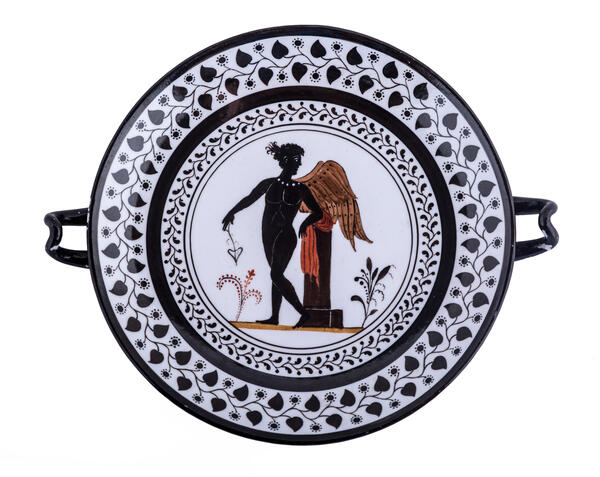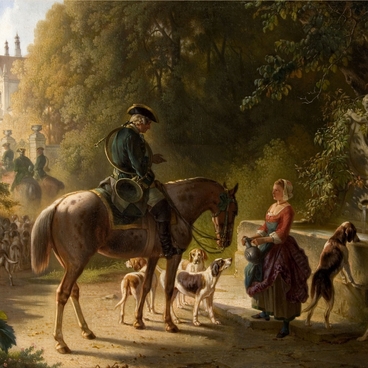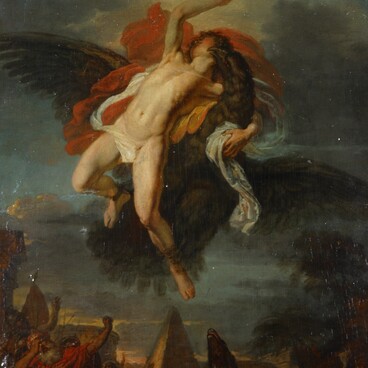In 1918, tea mug and saucer set, rosettes and jugs in the “Greek” style arrived from the Karacharovsky estate of the Counts Uvarov.
The presented saucer from the set painted in the Etruscan style. Since the middle of the XVIII century, almost all monuments of ancient Greek ceramics are attributed to the Etruscans. The ancient vases found during the excavations of the necropolis in Etruria in the 1820s were also determined as Etruscan ones. Classical forms, tropes and coloristic manner of antique vase painting, creatively used in new forms, are generally named “Etruscan style”. The fashion for Etruscan porcelain painting was popular in various porcelain manufactories since the second half of the XVIII century. The fascination with the heritage of antiquity was characteristic of the first third of the XIX century, a major role in this was played by the discovery of Pompeii — an ancient city that perished during the eruption of Vesuvius in 79 AD. The artifacts preserved under the ash layer began to be discovered during archaeological excavations begun in the middle of the XVIII century. Etruscan art was an important stylistic source for historicism — the leading style in the reign of Nicholas I (reign 1825-1855).
Items in the antique style made at the Imperial Porcelain Factory in the first third of the XIX century and later finishings to the “Etruscan sets” are quite well known. Porcelain items in the Etruscan style, produced at private factories in the Russian Empire, are not numerous in museum collections.
The saucer from the museum collection was made in the 1800s — 1825 at the Franz Yakovlevich Gardner porcelain factory. It has the form of an antique vessel — a low kylix with two loop handles bent upwards. The overglaze painting is on a white background. This type of painting is performed after baking, then the item is burnt at a relatively low temperature of 700-900 °C. The shape and coloristic manner of the saucer is close to the white-background antique ceramics of the VI century BC, but this is not a perfect copy, but a free interpretation of the ancient plot. In the center of the mirror there is a plastic and relaxed black figure of a young Erotic man with ochre wings with ivy shoot in his hand. Erot leans his hand on the black column. A strip of black floral ornament — a branch of ivy is along the saucer side.
The presented saucer from the set painted in the Etruscan style. Since the middle of the XVIII century, almost all monuments of ancient Greek ceramics are attributed to the Etruscans. The ancient vases found during the excavations of the necropolis in Etruria in the 1820s were also determined as Etruscan ones. Classical forms, tropes and coloristic manner of antique vase painting, creatively used in new forms, are generally named “Etruscan style”. The fashion for Etruscan porcelain painting was popular in various porcelain manufactories since the second half of the XVIII century. The fascination with the heritage of antiquity was characteristic of the first third of the XIX century, a major role in this was played by the discovery of Pompeii — an ancient city that perished during the eruption of Vesuvius in 79 AD. The artifacts preserved under the ash layer began to be discovered during archaeological excavations begun in the middle of the XVIII century. Etruscan art was an important stylistic source for historicism — the leading style in the reign of Nicholas I (reign 1825-1855).
Items in the antique style made at the Imperial Porcelain Factory in the first third of the XIX century and later finishings to the “Etruscan sets” are quite well known. Porcelain items in the Etruscan style, produced at private factories in the Russian Empire, are not numerous in museum collections.
The saucer from the museum collection was made in the 1800s — 1825 at the Franz Yakovlevich Gardner porcelain factory. It has the form of an antique vessel — a low kylix with two loop handles bent upwards. The overglaze painting is on a white background. This type of painting is performed after baking, then the item is burnt at a relatively low temperature of 700-900 °C. The shape and coloristic manner of the saucer is close to the white-background antique ceramics of the VI century BC, but this is not a perfect copy, but a free interpretation of the ancient plot. In the center of the mirror there is a plastic and relaxed black figure of a young Erotic man with ochre wings with ivy shoot in his hand. Erot leans his hand on the black column. A strip of black floral ornament — a branch of ivy is along the saucer side.



